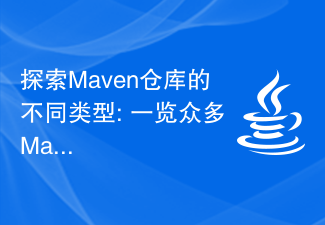 Java
Java javaTutorial
javaTutorial Explore the different types of Maven repositories: Overview of the many Maven repository types
Explore the different types of Maven repositories: Overview of the many Maven repository types
Maven is a popular project management and build tool. It helps developers manage dependencies and build processes during project development. In Maven, the warehouse is an important concept used to store the project's dependent libraries. Maven warehouses can be divided into local warehouses, remote warehouses and central warehouses. This article will explore the different Maven repository types.
- Local warehouse
The local warehouse is the default warehouse type used by Maven. It is located in the local file system on the developer's computer. When we build the project for the first time, Maven will automatically create a local warehouse in the ".m2" directory of the user's home directory. The local repository contains copies of downloaded dependent libraries. When we build the project, Maven will first check whether the required dependent libraries exist in the local warehouse. If found, it will be copied to the project's .classpath for compilation and running. If the required dependent library does not exist in the local warehouse, Maven will automatically download it from the remote warehouse and save it in the local warehouse for future use. - Remote warehouse
The remote warehouse is a remote server that stores Maven project dependent libraries. When Maven needs to download a dependent library, it will first check whether a copy of the library exists in the local warehouse. If the local repository does not exist, Maven will download the dependent library from the remote repository and save it in the local repository for future use. The remote warehouse can be a private warehouse maintained within the company, or a public open source warehouse, such as the Maven central warehouse. - Central Warehouse
The central warehouse is one of Maven's most important remote warehouses and is the default remote warehouse. It contains a large number of commonly used open source Java libraries and frameworks, such as Spring, Hibernate, JUnit, etc. When we declare a dependency in the project's pom.xml file, Maven will first check whether the dependent library exists in the local warehouse. If not found, it is downloaded from the central repository and saved in the local repository.
The central warehouse provides services through global mirrors to improve download speed and reliability. Users can choose the appropriate mirror based on their location and needs. Some common central warehouse images include Alibaba Cloud, Tsinghua University, etc.
- Private warehouse
Private warehouse is a warehouse built and maintained by a company or individual. It contains only the specific dependency libraries required by the organization or individual. Private repositories can help teams share and manage project dependencies internally. Companies often store internally developed libraries, customized versions of third-party libraries, or other useful tools and plugins in private repositories. Private warehouses are more flexible and controllable than central warehouses. Many companies choose to use tools such as Sonatype Nexus or JFrog Artifactory to build private warehouses.
Summary:
The Maven warehouse is an important part of managing project dependencies. The local repository stores copies of the project's dependent libraries, the remote repository is used to download and save dependent libraries, and the central repository provides a wide range of open source Java libraries and frameworks. In addition, private warehouses are proprietary warehouses built within an organization or individual to store customized dependency libraries and tools. Understanding the different types of Maven repositories can help developers better manage project dependencies and improve development efficiency.
The above is the detailed content of Explore the different types of Maven repositories: Overview of the many Maven repository types. For more information, please follow other related articles on the PHP Chinese website!
 揭示canvas属性的奥秘Jan 17, 2024 am 10:08 AM
揭示canvas属性的奥秘Jan 17, 2024 am 10:08 AM探索canvas属性的秘密,需要具体代码示例Canvas是HTML5中一个非常强大的图形绘制工具,通过它我们可以轻松地在网页中绘制出复杂的图形、动态的效果以及游戏等。但是,为了使用它,我们必须熟悉Canvas的相关属性和方法,并掌握它们的使用方式。在本文中,我们将对Canvas的一些核心属性进行探讨,并提供具体的代码示例,以帮助读者更好地理解这些属性应如何使
 Go语言中常用数据库选择的探索Jan 28, 2024 am 08:04 AM
Go语言中常用数据库选择的探索Jan 28, 2024 am 08:04 AM探索Go语言中常用的数据库选择引言:在现代的软件开发中,无论是Web应用、移动应用还是物联网应用,都离不开数据的存储和查询。而在Go语言中,我们有许多优秀的数据库选择。本文将探索Go语言中常用的数据库选择,并提供具体的代码示例,帮助读者了解和选择适合自己需求的数据库。一、SQL数据库MySQLMySQL是一种流行的开源关系型数据库管理系统。它支持广泛的功能和
 了解Ajax框架:探索常见的五种框架Jan 26, 2024 am 09:28 AM
了解Ajax框架:探索常见的五种框架Jan 26, 2024 am 09:28 AM了解Ajax框架:探索常见的五种框架,需要具体代码示例引言:在现代Web应用开发中,Ajax是必不可少的技术之一。它以其支持异步数据交互,提升用户体验等特点,成为了前端开发中不可或缺的一部分。为了更好地了解和掌握Ajax框架,本文将介绍五种常见的Ajax框架,并提供具体的代码示例,帮助读者深入了解这些框架的使用方法和优势。一、jQueryjQuery是目前最
 深入探究kernel panic:为何它能保护系统Dec 29, 2023 am 09:08 AM
深入探究kernel panic:为何它能保护系统Dec 29, 2023 am 09:08 AM探索KernelPanic:为什么它是系统的保护机制,需要具体代码示例引言:在计算机系统中,KernelPanic(内核恐慌)是一种系统保护机制,它在遇到无法解决的问题时,强制操作系统进入非正常终止状态。当操作系统无法保证其正常运行时,电脑会显示类似于“KernelPanic”的错误信息,并停止运行。本文将探索KernelPanic背后的原理与机制,
 Java常用邮件发送工具类的探索Dec 27, 2023 am 08:41 AM
Java常用邮件发送工具类的探索Dec 27, 2023 am 08:41 AM探索Java中常用的邮件发送工具类随着互联网的快速发展,电子邮件已经成为人们日常生活和工作中不可或缺的一部分。在Java开发中,我们经常需要使用邮件发送功能,如注册确认邮件、密码重置邮件、系统通知等。为了提高开发效率和代码的可维护性,我们通常会使用邮件发送工具类来简化邮件发送的操作。Java中常用的邮件发送工具类有很多,如JavaMail、SpringFr
 必备工具:了解常用的Ajax请求库有哪些?Jan 30, 2024 am 11:00 AM
必备工具:了解常用的Ajax请求库有哪些?Jan 30, 2024 am 11:00 AM开发必备:探索常用的Ajax请求库有哪些?在现代前端开发中,使用Ajax进行异步请求已经成为一种标配,而选择合适的Ajax请求库可以让我们更加高效地处理网络请求,提升开发效率和用户体验。本文将探索一些常用的Ajax请求库,帮助开发者选择适合自己项目的工具。jQueryAjax:作为最流行的JavaScript库之一,jQuery提供了强大的Ajax请求功
 探索cookie的所在地:它们究竟存放在哪里?Jan 19, 2024 am 09:53 AM
探索cookie的所在地:它们究竟存放在哪里?Jan 19, 2024 am 09:53 AM随着互联网技术的不断发展,我们在网站上浏览信息、购物、支付等行为是司空见惯。而为了方便用户浏览网站,网站服务器会将一些数据保存在用户的浏览器上,在用户下次访问该网站时,这些数据会被提取出来供服务器使用。这种保存数据的一种机制就是cookie。那么,cookie到底存放在哪里呢?本文将会对cookie的存储位置进行探讨,并提供一些代码示例。Cookie的存储位
 探索Maven仓库的不同类型: 一览众多Maven仓库的类型Jan 05, 2024 pm 02:26 PM
探索Maven仓库的不同类型: 一览众多Maven仓库的类型Jan 05, 2024 pm 02:26 PMMaven是一个流行的项目管理和构建工具。它可以帮助开发人员在项目开发期间管理依赖关系和构建过程。在Maven中,仓库是一个重要的概念,用于存储项目的依赖库。Maven仓库可以分为本地仓库、远程仓库和中央仓库。本文将探索不同的Maven仓库类型。本地仓库本地仓库是Maven默认使用的仓库类型。它位于开发者计算机上的本地文件系统中。当我们第一次构建项目时,Ma


Hot AI Tools

Undresser.AI Undress
AI-powered app for creating realistic nude photos

AI Clothes Remover
Online AI tool for removing clothes from photos.

Undress AI Tool
Undress images for free

Clothoff.io
AI clothes remover

AI Hentai Generator
Generate AI Hentai for free.

Hot Article

Hot Tools

MinGW - Minimalist GNU for Windows
This project is in the process of being migrated to osdn.net/projects/mingw, you can continue to follow us there. MinGW: A native Windows port of the GNU Compiler Collection (GCC), freely distributable import libraries and header files for building native Windows applications; includes extensions to the MSVC runtime to support C99 functionality. All MinGW software can run on 64-bit Windows platforms.

mPDF
mPDF is a PHP library that can generate PDF files from UTF-8 encoded HTML. The original author, Ian Back, wrote mPDF to output PDF files "on the fly" from his website and handle different languages. It is slower than original scripts like HTML2FPDF and produces larger files when using Unicode fonts, but supports CSS styles etc. and has a lot of enhancements. Supports almost all languages, including RTL (Arabic and Hebrew) and CJK (Chinese, Japanese and Korean). Supports nested block-level elements (such as P, DIV),

WebStorm Mac version
Useful JavaScript development tools

Atom editor mac version download
The most popular open source editor

ZendStudio 13.5.1 Mac
Powerful PHP integrated development environment





